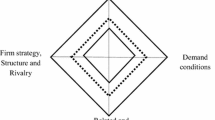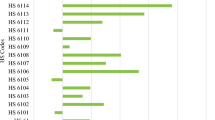Abstract
The study aimed to analyze and evaluate the competitiveness of the Turkish textile industry, using the revealed comparative advantage approach, to identify the opportunities and threats that the textile industry faces in global markets. The paper compared the major countries in the textile industry, such as India, China, Vietnam, Turkey, and the United States during the 2010–2019 time series, using Balassa’s “revealed comparative advantage” (RCA) approach. The findings revealed that the amount of exports is insufficient for determining an industry’s competitiveness; in the instance of Turkish textile products, the RCA value is greater than 1, indicating that the country has a comparative advantage. As a consequence of the comparison, Turkey came in third place, after Pakistan and Vietnam, and ahead of the United States, China, Hong Kong, India, and South Korea, with RCA values ranging from 1 to 1.3 between 2010 and 2019, indicating a positive trend in the industry's competitiveness.

Similar content being viewed by others
Availability of Data and Material (Data Transparency)
The data about this study are available on request from the corresponding author.
Code Availability
Not applicable.
Notes
Export Product Share (%): The share of total merchandise trade exports, accounted for by the product in a given year.
References
Altay, O., Gacaner, A. (2003). Turkey’s dynamics of competition: A comparative analysis of competitiveness of the textile and clothing ındustry. paper presented at the VII.ERC/METU International Economy Congress, Ankara.
Balassa, B. (1965). Trade liberalization and revealed comparative advantage. Manchester School of Economic and Social Studies, 33, 99–123.
Clark, D., Sawyer, Ch., & Sprinkle, R. (2007). Revealed comparative advantage indexes for regions of the United States. Global Economy Journal. https://doi.org/10.2202/1524-5861.1033·
Dhiman, R., & Sharma, M. (2017). Export competitiveness of indian textile industry: Revealed comparative advantage analysis. International Journal of Applied Business and Economic Research, 15(9), 295–305.
Ferman, M., Akgüngör, S., & Yüksel, A. H. (2004). The competitiveness of Turkey and its sustainability: A comparison in the EU market from the perspectives of the rival countries and Turkey. In: 2004 Economy Congress of Turkey, 4–29.
Halife, H. (2020). Analysis Of Competitiveness of Turkish Textile Sector Based on The Porter’s Diamond Model. Stratejik Yönetim Araştırmaları Dergisi, 3(1), 27–49.
Halife, H., & Alshukur, M. (2022). Impact of revenue-sharing contracts on improving profits for manufacturers and suppliers in the supply chain of organic textile products. International Journal of Business Performance and Supply Chain Modelling, 13(1), 69–88.
Istanbul Textile and Apparel Exporters Associations (IHKIB). (2017). Web: https://www.ihkib.org.tr/tr
Karaalp, H. S., & Yilmaz, N. D. (2013). Comparative Advantage of Textiles and Clothing: Evidence for Bangladesh, China, Germany and Turkey. Fibres and Textiles in Eastern Europe, 97(1), 14–17.
Karakaya, E., & BaskanOzgen, F. (2002). Economic Feasibility of Turkey's Economic Integration with the EU: Perspectives from Trade Creation and Trade Diversion. In: International Economics Research Conference, September, pp. 11–14.
Kutluksaman, M., Mutlu, I., Unluaslan, E. (2012). Turkey’s Textiles and Apparel Cluster Microeconomics of Competitiveness HBS/HKS Michael Porter. http://www.isc.hbs.edu/pdf/Student_Projects/2012%20MOC%20Papers/MOC%20-%20Turkey%20Textiles%20and%20Apparel%20Cluster.pdf.
Mahmood, Z., & Al-Hajji, R. (2009). Revealed comparative advantage of non-petroleum products in Kuwait. NUST Journal of Business and Economics, 2(1), 32–41.
Momaya, K. S. (2016). City clusters and break-out in corporate competitiveness: Patterns and perspectives focusing on innovation capabilities and India. Competitiveness Review, 26(4), 415–434.
Ruffin, R. (2002). David Ricardo’s discovery of comparative advantage. History of Political Economy, 34(4), 727–748.
Shahzad, K. (2015). An RCA analysis of textiles and clothing in Pakistan, India, and Bangladesh. Lahore Journal of Economics, 20(1), 157–168.
Sinanan, D., & Hosein, R. (2012). Transition probability matrices and revealed comparative advantage persistence in a small hydrocarbon-based economy. West Indian Journal of Engineering, 34(1/2), 16–29.
Tudor, L. (2018). Change in textile and clothing industry. Industria Textila, 69(1), 37–43.
Varian, B. (2016). The revealed comparative advantages of late-Victorian Britain. Economic History. Working Papers in School of Economics. No: 239/2016, London.
World Bank Statistics Database. (2022). http://data.worldbank.org/
World Trade Statistical Review. (2017). Web: https://www.wto.org.
Yılmaz, B. (2003). Turkey’s competitiveness in the European Union: A comparison with five candidate countries - Bulgaria, The Czech Republic, Hungary, Poland, Romania, and the EU15. The Eastward Enlargement of the Eurozone Research Project (Ezoneplus), 5th Framework Programme. Working Paper, No.12.
Acknowledgements
I'd like to thank the anonymous reviewers and the Editor-in-Chief for their constructive feedback on how to improve the research paper. Their advice has assisted me in improving the robustness of my research paper.
Funding
The author did not receive support from any organization for the submitted work. Financial interests: The author has no relevant financial or non-financial interests to disclose.
Author information
Authors and Affiliations
Contributions
The work is entirely my own creation and was not plagiarized.
Corresponding author
Ethics declarations
Conflict of Interest
There is no conflict of interest, and the work is the author's original.
Ethical Approval
No ethical approval is required. (Author is responsible for correctness of the statements provided in the manuscript).
Rights and permissions
Springer Nature or its licensor holds exclusive rights to this article under a publishing agreement with the author(s) or other rightsholder(s); author self-archiving of the accepted manuscript version of this article is solely governed by the terms of such publishing agreement and applicable law.
About this article
Cite this article
Halife, H. Competitiveness Analysis of Textile Industry of Turkey: Revealed Comparative Advantage Approach. JGBC 17 (Suppl 1), 25–30 (2022). https://doi.org/10.1007/s42943-022-00062-y
Received:
Accepted:
Published:
Issue Date:
DOI: https://doi.org/10.1007/s42943-022-00062-y




